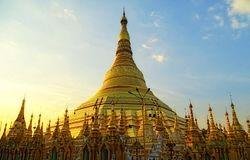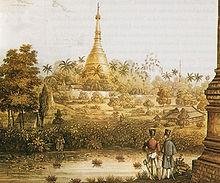Shwedagon Pagoda is the most sacredBuddhist pagoda in Myanmar, as it is believed to contain relics of the four previous Buddhasof the present kalpa. These relics include the staff of Kakusandha, the water filter ofKoṇāgamana, a piece of the robe of Kassapa, and eight strands of hair from the head ofGautama.
Historians and archaeologists maintain that the pagoda was built by the Mon peoplebetween the 6th and 10th centuries CE.[2]However, according to legend, the Shwedagon Pagoda was constructed more than 2,600 years ago, which would make it the oldest Buddhist stupa in the world.[3] According to tradition, Taphussa and Bhallika — two merchant brothers from the north of Singuttara Hill what is currently Yangon met the Lord Gautama Buddha during his lifetime and received eight of the Buddha's hairs. The brothers returned to Burma and, with the help of the local ruler, King Okkalapa, found Singuttara Hill, where relics of other Buddhas preceding Gautama Buddha had been enshrined.[citation needed] When the king opened the golden casket in which the brothers had carried the hairs, incredible things happened:
“There was a tumult among men and spirits ... rays emitted by the Hairs penetrated up to the heavens above and down to hell ... the blind beheld objects ... the deaf heard sounds ... the dumb spoke distinctly ... the earth quaked ... the winds of the ocean blew ... Mount Meru shook ... lightning flashed ... gems rained down until they were knee deep ... all trees of the Himalayas, though not in season, bore blossoms and fruit.
The stupa fell into disrepair until the 14th century, when King Binnya U (1323–1384) rebuilt it to a height of 18 m (59 ft). A century later, Queen Binnya Thau (1453–1472) raised its height to 40 m (131 ft). She terraced the hill on which it stands, paved the top terrace with flagstones, and assigned land and hereditary slaves for its maintenance. Binnya Thau yielded up the throne to her son-in-lawDhammazedi in 1472, retiring to Dagon. During her last illness she had her bed placed so that she could look upon the gilded dome of the stupa. The Mon face of the Shwedagon inscription catalogues a list of repairs beginning in 1436 and finishing during Dhammazedi's reign. By the beginning of the 16th century, Shwedagon Pagoda had become the most famous Buddhist pilgrimage site in Burma.
A series of earthquakes during the following centuries caused damage. The worst damage was caused by a 1768 earthquake that brought down the top of the stupa, but KingHsinbyushin later raised it to its current height of 99 m (325 ft). A new crown umbrella was donated by King Mindon Min in 1871 after the annexation of Lower Burma by the British. An earthquake of moderate intensity in October 1970 put the shaft of the crown umbrella visibly out of alignment. A scaffold was erected and extensive repairs were made.
From 22 February 2012 to 7 March 2012, devotees celebrated the annual Shwedagon Pagoda Festival for the first time since 1988, when it was banned by the governing State Law and Order Restoration Council.[6][7]Celebrations began at the Rahu corner of the pagoda's yinbyin platform, at the Maha Pahtan and Aung Myay central platforms, at 9 am. on 22 February.[8] The Shwedagon Pagoda Festival, which is the largest pagoda festivalin the country, begins during the new moon of the month of Tabaung in the traditionalBurmese calendar and continues until the full moon.




Hi! I am a robot. I just upvoted you! I found similar content that readers might be interested in:
https://en.wikipedia.org/wiki/Shwedagon_Pagoda
Done bro
Done.. bro
Copy ဆိုရင္ စာသားနည္းနည္းေျပာင္းလိုက္
thanks bro :-)
good done
done bro